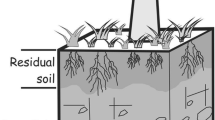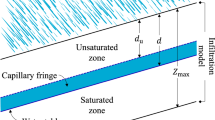Abstract
This paper describes the potential applicability of a hydrological–geotechnical modeling system using satellite-based rainfall estimates for a shallow landslide prediction system. The physically based distributed model has been developed by integrating a grid-based distributed kinematic wave rainfall-runoff model with an infinite slope stability approach. The model was forced by the satellite-based near real-time half-hourly CMORPH global rainfall product prepared by NOAA-CPC. The method combines the following two model outputs necessary for identifying where and when shallow landslides may potentially occur in the catchment: (1) the time-invariant spatial distribution of areas susceptible to slope instability map, for which the river catchment is divided into stability classes according to the critical relative soil saturation; this output is designed to portray the effect of quasi-static land surface variables and soil strength properties on slope instability and (2) a produced map linked with spatiotemporally varying hydrologic properties to provide a time-varying estimate of susceptibility to slope movement in response to rainfall. The proposed hydrological model predicts the dynamic of soil saturation in each grid element. The stored water in each grid element is then used for updating the relative soil saturation and analyzing the slope stability. A grid of slope is defined to be unstable when the relative soil saturation becomes higher than the critical level and is the basis for issuing a shallow landslide warning. The method was applied to past landslides in the upper Citarum River catchment (2,310 km2), Indonesia; the resulting time-invariant landslide susceptibility map shows good agreement with the spatial patterns of documented historical landslides (1985–2008). Application of the model to two recent shallow landslides shows that the model can successfully predict the effect of rainfall movement and intensity on the spatiotemporal dynamic of hydrological variables that trigger shallow landslides. Several hours before the landslides, the model predicted unstable conditions in some grids over and near the grids at which the actual shallow landslides occurred. Overall, the results demonstrate the potential applicability of the modeling system for shallow landslide disaster predictions and warnings.




















Similar content being viewed by others
References
Apip, Sayama T, Tachikawa Y, Takara K (2008a) Lumping of a physically-based distributed model for sediment runoff prediction in a catchment scale. Annual Journal of Hydraulic Engineering (JSCE) 52:43–48
Apip, Tachikawa Y, Sayama T, Takara T (2008b) Lumping a physically-based distributed sediment runoff model with embedding river channel sediment transport mechanism. Annuals of Disaster Prevention Research Institute, Kyoto University 51A:103–118
Beven KJ (1989) Changing ideas in hydrology—the case of physically based models. J Hydrol 105:157–72
Borga M, Fontana GD, Gregoretti C, Marchi L (2002) Assessment of shallow landsliding by using a physically based of hillslope stability. Hydrol Process 16:2833–2851
Burton A, Bathurst JC (1998) Physically based modelling of shallow landslide sediment yield at a catchment scale. Environ Geol 35(2–3):89–99
Caine N (1980) The rainfall intensity–duration control of shallow landslides and debris flows. Geogr Ann A62:23–27
Chang K, Chiang SH, Lei F (2008) Analysing the relationship between typhoon-triggered landslides and critical rainfall conditions. Earth Surf Process Land 33:1261–1271
Cardinali M, Galli M, Guzzetti F, Ardizzone F, Reichenbach P, Bartoccini P (2006) Rainfall induced in December 2004 in Southwestern Umbria, Central Italy. Natural Hazards and Earth System Science 6:237–260
Casadei M, Dietrich WE, Miller NL (2003) Testing a model for predicting the timing and location of shallow landslide initiation in soil-mantled landscapes. Earth Surf Process Land 28:925–950
Cole SJ, Moore RJ (2009) Distributed hydrological modeling using weather radar in gauged and ungauged basins. Adv Water Resour 32:1107–1120
Dai FC, Lee CF (2003) A spatiotemporal probabilistic modeling of storm-induced shallow landsliding using aerial photographs and logistic regression. Earth Surf Process Land 25:527–545
D’Odorico P, Fagherazzi S (2003) A probabilistic model of rainfall-triggered shallow landslides in hollows: a long-term analysis. Water Resour Res 39(9):1262
FAO (2003) The digital soil map of the world and derived soil properties, version 3.6. FAO/UNESCO, Rome, Italy
Guzzetti F, Peruccacci S, Rossi M, Stark CP (2008) The rainfall intensity-duration control of shallow landslides and debris flows: an update. Landslides 5(1):3–17
Hong Y, Adler RF (2008) Predicting global landslide spatiotemporal distribution: integrating landslide susceptibility zoning techniques and real-time satellite rainfall estimates. Int J Sediment Res 23:249–257
Hong Y, Hiura H, Shino K, Sassa K, Fukuoka H (2005) Quantitative assessment on the influence of heavy rainfall on the crystalline schist landslide by monitoring system-case study on Zentoku landslide, Japan. Landslides 2(1):31–41
Hong Y, Adler RF, Negri A, Huffman GJ (2007) Flood and landslide applications of near real-time satellite rainfall products. Nat Hazards 43:285–294
Iida TA (1999) Stochastic hydro-geomorphological model for shallow landsliding due to rainstorm. Catena 34(3–4):293–313
Inverson RM (2000) Landslide triggering by rain infiltration. Water Resources Research 36:1897–1910
Jacob M, Holm K, Lange O, Schwab JW (2006) Hydrometeorological thresholds for landslide initiation and forest operation shutdowns on the north coast of British Columbia. Landslides 3(3):228–238
Joyce RJ, Janowiak JE, Arkin PA, Xie P (2004) CMORPH: a method that produces global precipitation estimates from passive microwave and infrared data at high spatial and temporal resolution. J Hydrometeorol 5:487–503
Kirschbaum DB, Adler R, Hong Y, Lerner-Lam A (2009) Evaluation of a preliminary satellite-based landslide hazard algorithm using global landslide inventories. Natural Hazards and Earth System Sciences 9:673–686
Kojima T, Takara K (2003) Grid-cell based distributed flood-runoff model and its performance, weather radar information and distributed hydrological modeling. IAHS Publications 282:234–240
Matsushi Y, Hattanji T, Matsukura Y (2006) Mechanisms of shallow landslides on soil-mantled hillslopes with permeable and impermeable bedrocks in the Boso Peninsula, Japan. Geomorphology 76:92–108
Montgomery DR, Dietrich WE (1994) A physically based model for the topographic control on shallow landsliding. Water Resour Res 30(4):1153–1171
Montgomery DR, Sullivan K, Greenberg M (1998) Regional test of a model for shallow landsliding. Hydrol Process 12:943–955
Montrasio L, Valentino R, Losi GL (2009) Rainfall-induced shallow landslides: a model for the triggering mechanism of some case studies in Northern Italy. Landslides 6(3):241–251
Morgan RPC, Quinton JN, Smith RE, Govers G, Poesen JWA, Auerswald K, Chisci G, Torri D, Styczen ME, Folly AJV (1998) The European Soil Erosion Model (EUROSEM): documentation and user guide. Cranfield University, Silsoe College
Nash JE, Sutcliffe JV (1970) River flow forecasting through conceptual models. I. A discussion of principles. J Hydrol 10:282–290
Nunos JP, Viera GN, Seixas J, Goncalvas P, Carvalhais N (2005) Evaluating the MEFEDIS model for runoff and soil erosion prediction during rainfall events. Catena 61:210–228
Salciarini D, Godt JW, Savage WZ, Conversini P, Baum RL, Michael JA (2006) Modeling regional initiation of rainfall-induced shallow landslides in the eastern Umbria Region of central Italy. Landslides 3(3):181–194
Sayama T, McDonnel JJ (2009) A new time-space accounting scheme to predict stream water residence time and hydrograph source components at the watershed scale. Water Resour Res 45:1–14
Sayama T, Takara K, Tachikawa Y (2003) Reliability evaluation of rainfall-sediment-runoff models. IAHS Publications 279:131–141
Sharma RR, Samarkoon L, Hazarika M, Kafle TP (2007) Applicability of tropical rainfall measuring mission to predict floods on the Bagmati River. J Hydrometeorol 4:1–15
Sheresta MS, Artan GA, Bajracharya SR, Sharma RR (2008) Using satellite-based rainfall estimates for streamflow modeling. J Flood Risk Management 1:89–99
Simoni S, Zanotti F, Bertoldi G, Rigon R (2008) Modelling the probability of occurrence of shallow landslides and channelized debris flows using GEOtop-FS. Hydrol Process 22(4):532–545
Tachikawa Y, Nagatani G, Takara K (2004) Development of stage-discharge relationship equation incorporating saturated-unsaturated flow mechanism. Annual Journal of Hydraulic Engineering (JSCE) 48:7–12
Takahashi T (1981) Estimation of potential debris flows and their hazardous zones; soft countermeasures for a disaster. Journal of Natural Disaster Science 3(1):57–89
Takahashi T (2007) Debris flow; mechanics, prediction and countermeasures: Taylor & Francis Group, London, UK: 448
Takeuchi K, Jayawardena AW, Takahashi Y (Eds) (1995) Catalogue of rivers for Southeast Asia and the Pacific — Volume I. The UNESCO-IHP Regional Steering Committee for Southeast Asia and the Pacific, UNESCO-IHP Publication, 103–114
Talebi A, Troch PA, Uijlenhoet R (2008) A steady-state analytical slope stability model for complex hillslopes. Hydrol Process 22:546–553
Versace P, Capparelli G (2008) Empirical hydrological models for early warning of landslides induced by rainfall. Proceedings of the 1st world landslide forum: 273-276
Wilkinson PL, Anderson MG, Lloyd DM (2002) An integrated hydrological model for rain-induced landslide prediction. Earth Surf Process Land 27:1285–1297
Wu W, Sidle RC (1995) A distributed slope stability model for steep forested basins. Water Resour Res 31(8):2097–2110
Wu P, Hamada J, Mori S, Tauhid YI, Yamanaka MD, Kimura F (2003) Diurnal variation of precipitable water over a mountainous area of Sumatera island. J Appl Meteorol 42:1107–1115
Wegener T, Wheater SH, Gupta VK (2004) Rainfall-runoff modelling-a review. In Rainfall-runoff modelling in gauged and ungauged catchments. Imperial College Press, London, pp 1–8
Acknowledgments
The support from the International Consortium on Landslides (ICL) and Disaster Prevention Research Institute (DPRI), Kyoto University under the project “Asian Joint Research for Early Warning Technology of Landslides” are gratefully acknowledged. The authors would like to thank Jhon E Janowiak (CPC-NOAA), Parwati Sofan (LAPAN, Indonesia), and Sumaryono (the Geological Agency of Indonesia) for their help with satellite-based rainfall information and providing the landslide inventory database.
Author information
Authors and Affiliations
Corresponding author
Rights and permissions
About this article
Cite this article
Apip, Takara, K., Yamashiki, Y. et al. A distributed hydrological–geotechnical model using satellite-derived rainfall estimates for shallow landslide prediction system at a catchment scale. Landslides 7, 237–258 (2010). https://doi.org/10.1007/s10346-010-0214-z
Received:
Accepted:
Published:
Issue Date:
DOI: https://doi.org/10.1007/s10346-010-0214-z




